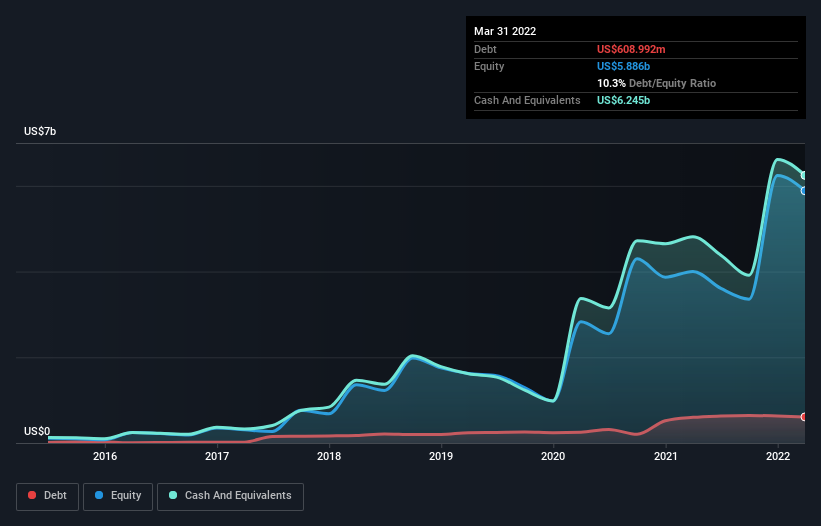
Legendary fund manager Li Lu (who Charlie Munger backed) once said, 'The biggest investment risk is not the volatility of prices, but whether you will suffer a permanent loss of capital.' So it seems the smart money knows that debt - which is usually involved in bankruptcies - is a very important factor, when you assess how risky a company is. Importantly, BeiGene, Ltd. (NASDAQ:BGNE) does carry debt. But the real question is whether this debt is making the company risky.
Why Does Debt Bring Risk?
Debt assists a business until the business has trouble paying it off, either with new capital or with free cash flow. Part and parcel of capitalism is the process of 'creative destruction' where failed businesses are mercilessly liquidated by their bankers. However, a more common (but still painful) scenario is that it has to raise new equity capital at a low price, thus permanently diluting shareholders. By replacing dilution, though, debt can be an extremely good tool for businesses that need capital to invest in growth at high rates of return. The first step when considering a company's debt levels is to consider its cash and debt together.
See our latest analysis for BeiGene
How Much Debt Does BeiGene Carry?
The chart below, which you can click on for greater detail, shows that BeiGene had US$609.0m in debt in March 2022; about the same as the year before. However, it does have US$6.24b in cash offsetting this, leading to net cash of US$5.64b.

How Healthy Is BeiGene's Balance Sheet?
Zooming in on the latest balance sheet data, we can see that BeiGene had liabilities of US$1.38b due within 12 months and liabilities of US$759.6m due beyond that. On the other hand, it had cash of US$6.24b and US$216.3m worth of receivables due within a year. So it can boast US$4.33b more liquid assets than total liabilities.
It's good to see that BeiGene has plenty of liquidity on its balance sheet, suggesting conservative management of liabilities. Given it has easily adequate short term liquidity, we don't think it will have any issues with its lenders. Simply put, the fact that BeiGene has more cash than debt is arguably a good indication that it can manage its debt safely. When analysing debt levels, the balance sheet is the obvious place to start. But ultimately the future profitability of the business will decide if BeiGene can strengthen its balance sheet over time. So if you want to see what the professionals think, you might find this free report on analyst profit forecasts to be interesting.
In the last year BeiGene's revenue was pretty flat, and it made a negative EBIT. While that hardly impresses, its not too bad either.
So How Risky Is BeiGene?
By their very nature companies that are losing money are more risky than those with a long history of profitability. And in the last year BeiGene had an earnings before interest and tax (EBIT) loss, truth be told. And over the same period it saw negative free cash outflow of US$2.0b and booked a US$1.9b accounting loss. But the saving grace is the US$5.64b on the balance sheet. That means it could keep spending at its current rate for more than two years. Overall, its balance sheet doesn't seem overly risky, at the moment, but we're always cautious until we see the positive free cash flow. There's no doubt that we learn most about debt from the balance sheet. But ultimately, every company can contain risks that exist outside of the balance sheet. For example, we've discovered 4 warning signs for BeiGene that you should be aware of before investing here.
When all is said and done, sometimes its easier to focus on companies that don't even need debt. Readers can access a list of growth stocks with zero net debt 100% free, right now.
Valuation is complex, but we're here to simplify it.
Discover if BeiGene might be undervalued or overvalued with our detailed analysis, featuring fair value estimates, potential risks, dividends, insider trades, and its financial condition.
Access Free AnalysisHave feedback on this article? Concerned about the content? Get in touch with us directly. Alternatively, email editorial-team (at) simplywallst.com.
This article by Simply Wall St is general in nature. We provide commentary based on historical data and analyst forecasts only using an unbiased methodology and our articles are not intended to be financial advice. It does not constitute a recommendation to buy or sell any stock, and does not take account of your objectives, or your financial situation. We aim to bring you long-term focused analysis driven by fundamental data. Note that our analysis may not factor in the latest price-sensitive company announcements or qualitative material. Simply Wall St has no position in any stocks mentioned.
About NasdaqGS:ONC
BeiGene
An oncology company, engages in discovering and developing various treatments for cancer patients in the United States, China, Europe, and internationally.
Very undervalued with high growth potential.
Similar Companies
Market Insights
Community Narratives



